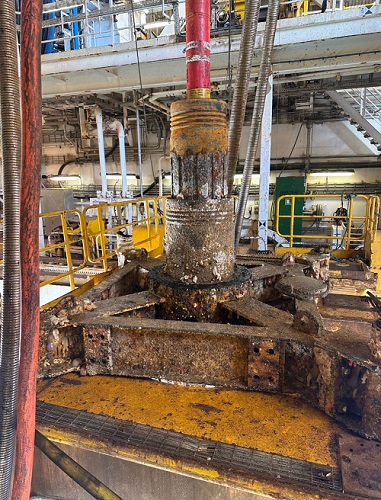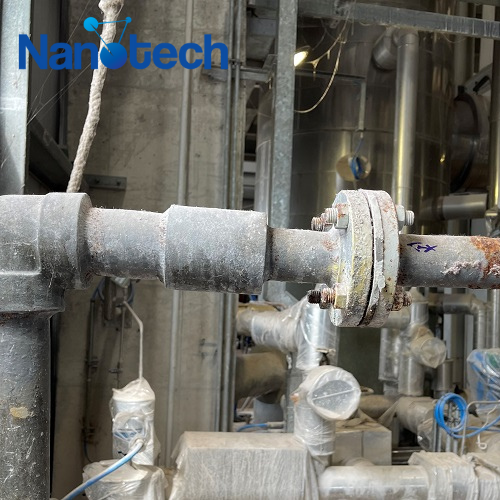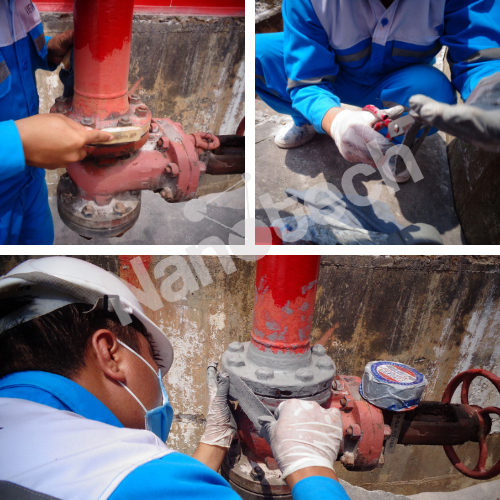One of the effective metal protection methods is the method of covering the reinforced metal surface with a layer of metallic or non-metallic material.
The coatings must satisfy the basic requirements of being airtight, impermeable, resistant to field primers, non-wearing, evenly distributed and tightly bonded to the parent metal surface. This is achieved by good preparation of the base metal surface and correct implementation of the engineering regimens.
Surface preparation is very important and necessary for all methods of coating and protection. Depending on the coating method and coating properties, there are different requirements for cleaning levels such as: rust removal, excess edge removal, polishing..

1.Heat method
The heat method is often used to remove rust on heavily rusted parts or structures or on surfaces with old paint, other organic contaminants…
People use burners (oil fields or Oxy – Acetylene fields) to heat the surface of the part, after burning it will peel off or be easily scraped off with an iron brush.
This method has high yield, but poor surface quality, low fuel consumption, thin parts ( <5mm ) are prone to warping, metal structure is easily changed by the heat effect of flame .
2. Mechanical method:
The mechanical method for rust removal is to use the action of mechanical force to make the rust peel off the metal surface. Can be divided into types:
a> Manual or mechanized rust removal:
The simple manual tools are rust scrapers, iron brushes…. manual scraping, low productivity, in order to increase productivity, create high surface quality, people use rust removal tools which are rotary brushes driven by direct electric motor or through soft rollers or transmission. by compressed air turbine.
b> Dry sandblasting :
Sandblasting is a method of preparing a surface of good quality. The working principle of dry sandblasting equipment is that sand comes out of the barrel, under the action of compressed air, is transported through a rubber hose through the nozzle and then collides with it. onto metal surface.
People often use dry quartz sand with a grain of 0.52mm, compressed air pressure of 2,540 at.
The dry sandblasting method has the disadvantage of toxic silica dust, so it must be carried out in a separate location and wear a dust mask. In addition, the metal surface after spraying rust quickly, so after spraying, it must be treated immediately.

Anti-corrosion by dry sandblasting
c> Wet sandblasting:
Use sand with a grain of 0.151 mm mixed with water to form a suspension, and use compressed air with a pressure of 1.5 8 at to spray the suspension onto the metal surface. In aqueous solution, a small amount of detergent is added to increase the cleaning process and a small amount of passivating agent is added to inhibit the corrosion process. Metal surface after wet sandblasting can be kept for up to 20 hours without rust.
The advantage of this method is that there is no dust, the metal surface is smoother, but for large or complex parts, it cannot be sprayed in the spray chamber.
d> Vibration rust removal:
It is a rust removal method thanks to the oscillation effect of parts and rough materials with an oscillation frequency of about 3000 oscillations/min.
Due to the effect of vibration, the surface of the work piece and the rough material rubbing against each other, the friction will remove the rust layer and smooth the surface.
3.Chemical method (corrosion method)
a> Acid rust removal:
This method is often used to remove rust for carbon steel or low alloy steel, can use H2S04 acid or HCL acid to remove rust.
The chemical action between the acid and the rust layer is metal oxides, forming soluble salts according to the following reactions:
Fe203 + 6H+ = 3H20 + 2Fe+3
Part of the rust is removed due to the action of the acid on the metal layer below the rust layer:
Fe + mH20 + 2H+ = Fe+2 + mH20 + H2
HCI acid rust removal is faster and the amount of hydrogen released is less than that of H2S04 acid, but because HCI acid evaporates strongly, it is difficult to store and transport, so it is very corrosive to metals, so it is rarely used.

Anti-corrosion by acid pickling
b> Acid pickling – Alkali combination :
This method is used to remove rust for acid-resistant, heat-resistant alloy steels and stainless steels. The process follows these steps:
+ Immerse the part in the molten mixture at 400480°C, a mixture of NaOH + NaN03 + NaCI substances, then wash the part with hot water.
+ Remove rust with solution of H2S04 + NaOH + NaN03 + NaCI at 4050°C, then wash with water and dry the surface.
Rust removal with this method is 2-3 times faster than the acid method and the surface quality is better.

Anti-corrosion by Acid rust removal – Alkali combination
c> Hydride rust removal:
Used to remove rust on the surface of alloys that are difficult to remove by other methods such as chromium alloy, titanium alloy. Sodium hydride reduces oxides to metals or soluble oxides according to the following reactions:
Fe304 + 4NaH = 3Fe + 4NaOH
NiO + NaH = Ni + NaOH
CuO + NaH = Cu + NaOH
Cr203 + NaH = 2CrO + 4NaOH
4. Electrochemical method.
For rusty metals that are difficult to remove by acid, the electrochemical method is used, the essence of which is to place the part in an electrolyte solution and connect the part to one pole of the power source. When the part is floating with the negative pole of the power supply, it is called cathode polarization. When the part is connected to the positive pole of the power supply, it is called anodic polarization. Cleaning by anodic polarization is more efficient than cathode polarization. It is also possible to connect the part to one pole of the AC power supply. In this case, the part is polarized according to the cycle of the power supply.
Under the effect of electric current, the rust is removed due to the complex electrochemical process in the electrolyte solution. Rust removal using alternating current is simpler and more convenient than using direct current. This method is only used for small parts in electroplating technology.
More articles for reference:
- Solution to prevent damage to the rig foot
- S2S Plip Tape anti-corrosion tape- convenient anti-corrosion solution for irregular surfaces.
- Knowledge of industrial paints
NANOTECH VIETNAM JOINT STOCK COMPANY
Address: No. 1747 Vo Nguyen Giap, Ward 12, Vung Tau City, Ba Ria – Vung Tau Province, Vietnam
Phone: 0254.3515.786 – 0778.828.879
Email: info@nanotechvietnam.com





